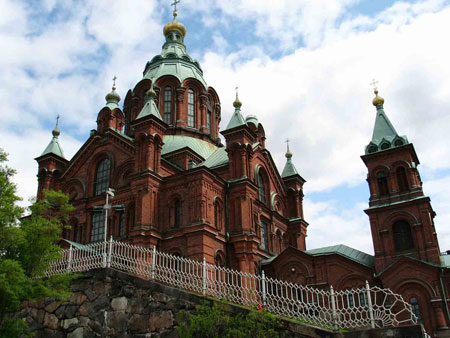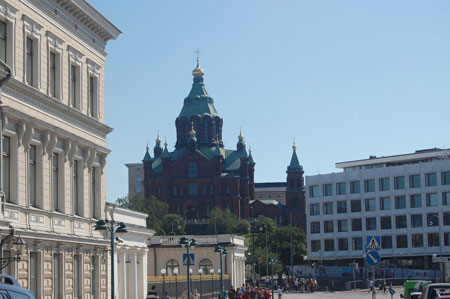History of the orthodox church in Finland

(Uspensky Orthodox Church-Helsinki)
The Christian faith spread to eastern Finland from Novgorod in the 12th century through the activities of monks and traders, but the real religious centres for the region were the monasteries, two of which were founded on islands in Lake Ladoga, those of Valamo (Russ. Valaam) early in the second millennium and Konevitsa (Russ. Konevets) towards the end of the 14th century. Later, in the 16th century, a monastery was founded at Petsamo (Russ. Pechenga) beside the Arctic Ocean. All of these monasteries were destroyed in the wars of the 16th and 17th century, in the course of which some of the western parts of Karelia were incorporated into the Kingdom of Sweden and part of their population fled to Central Russia while some remained in their home areas and adopted the Lutheran religion. When the parts of Karelia around Lake Ladoga were re-captured by Peter the Great in the early 18th century, the Orthodox faith also regained its status in the area, and the monasteries of Valamo and Konevitsa were rebuilt on their historic sites. The northern monastery of Petsamo was re-established at the end of the 19th century, and around the same time a community of nuns was set up at Kivennapa on the Karelian Isthmus which later became the Convent of Lintula.
After the war between Sweden and Russia came to an end with the Treaty of Hamina in 1809, the province of Viipuri (Russ. Vyborg) was annexed to Finland, which had become a Grand Duchy of the Russian Empire, and the Orthodox population of Finland increased by a factor of ten. The outcome of these political changes was that Orthodox merchants, soldiers and officials gradually moved to live permanently in other towns throughout the country. At the same time a separate church administration for Finland was set up under the Diocese of St. Petersburg, and in 1892 this became an independent Diocese of Finland and Viipuri, serving a varied population made up of Karelians, Russians, Finns and Skolt Saame.
When Finland gained its independence as a consequence of the Russian Revolution, the Orthodox Church acquired the status of a national church alongside the Lutheran Church. In 1921 Patriarch Tikhon of Russia granted autonomy to the Finnish church, and in view of the political turmoil in the Soviet Union and the difficulties of maintaining contacts in that direction, the Orthodox Synod of Finland applied to be taken under the protection of the Patriarchate of Constantinople. This was granted in a document (Gk. tomos) of 6.7.1923, under which the Finnish Orthodox Church became an autonomous archbishopric of the Patriarchate of Constantinople.
In the years preceding the Second World War the focus of activities was on Karelia, where the majority of the parishes were, but after the war, with the resettlement of the population of the ceded territories of Karelia over the rest of Finland, a new, comprehensive network of parishes was created, new churches were built, mainly in the 1950s, and the country was divided at first into two dioceses, that of Karelia, covering the central and eastern parts of the country, and that of Helsinki, covering the southern part, western part and Lapland in the north. It was in 1979 that the position of Bishop of Joensuu was created to provide a suffragan bishop to assist the archbishop, and later in the same year the Diocese of Oulu was created and a metropolitan chosen for it. This new diocese began to function in January 1980.
The church today

Administration
The Finnish Orthodox Church is an autonomous Orthodox church that belongs to the Ecumenical Patriarchate of Constantinople. It has about 60,000 members and is led by Archbishop Leo of Karelia and All Finland.
The church is divided into three dioceses, those of Karelia, Helsinki and Oulu. The Diocese of Karelia is headed by the Archbishop and the other two by metropolitans. The Archbishop is also assisted by a suffragan bishop known as the Bishop of Joensuu. There are 24 Orthodox parishes in Finland, a monastery and a convent. The church observes the New, or Gregorian Calendar.
The highest legislative bodies are the Church Assembly and the Council of Bishops, while the Synod is responsible for the church’s administration and executive functions. The Finnish Orthodox Church is the second national church of Finland alongside the Evangelical Lutheran Church, and its parishes have the right to levy taxes.

Orthodox Church, Tornio
Education
The training of priests, cantors and teachers of religion takes place at the University of Joensuu, where the Department of Orthodox Theology within the Faculty of Theology runs degree courses that serve as qualifications for positions in the church. It is also possible to take other degree courses in Orthodox theology at the university.
The Orthodox Church itself has a Seminary at Joensuu which, under the supervision of the Archbishop, provides the liturgical practice and spiritual guidance required by candidates for church positions. The seminary has its own church and accommodation for those intending to enter holy orders.
The Valamo Lay Academy is the only adult education college in Finland that operates in the spirit of Orthodoxy. Its courses are open to all, regardless of religious affiliation. It arranges over a hundred short courses a year on a wide variety of topics, and also a few longer ones lasting several months, e.g. on icon painting.
Many parishes also hold educational courses for their members and others interested, including discussion groups on the Orthodox faith, groups for those wishing to be admitted to the church and many other study groups. Various organizations functioning within the church also have educational programmes of their own.
Classes of religious instruction for Orthodox children are provided in the compulsory junior and secondary schools and in the upper secondary schools. These are arranged by the local education authorities.
If you are considering joining the Orthodox Church it is important that you should consult the parish priest of your area and arrange a meeting with him to discuss the matter.